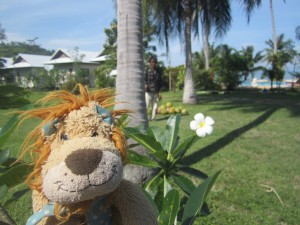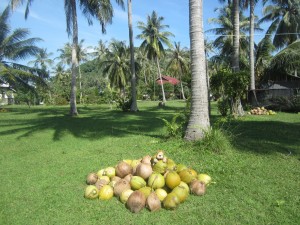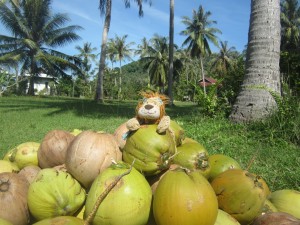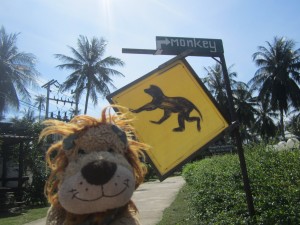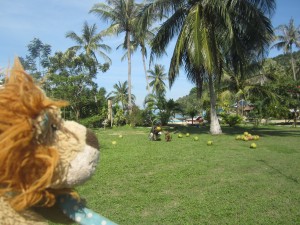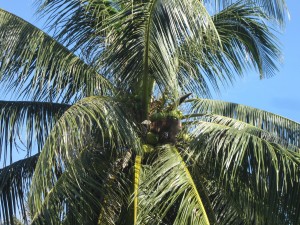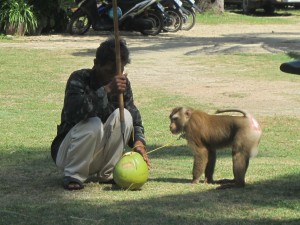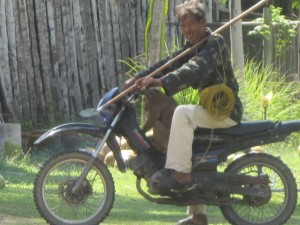At the Phangka Paradise Beach Resort, Lewis the Lion had a daily, short walk through the coconut trees from his beach bungalow to the beach restaurant for breakfast.
However, his normal, quiet meander across this morning wasn’t like other mornings as it seemed to be a hive of activity. There were many people gathered around, collecting up the coconuts that had been scattered to the ground. What had happened? Lewis the Lion wondered.
Whatever had happened, it didn’t take him long to seize the opportunity to play a quick game of hide and seek, knowing that his fur might blend into the stack of unripened coconuts on the ground. What a smart lion he was as Helen called out, “Where are you?” and Lewis the Lion had a little chuckle to himself!
However the game was short-lived as all of a sudden, a big monkey on a thick chain made an aggressive lunge towards him.
Lewis the Lion had seen that the hotel owners had designed their own “Beware” sign with a monkey on it but up till now did not understand why.
Luckily, his keeper hung on tightly to the chain and quickly distracted to the monkey back to the task in hand. This specially trained monkey called a ling gaeng, was harvesting the coconuts from the trees above.
Lewis the Lion saw the monkey scampering quickly up the tree and then with both of its hands rolling the coconuts out behind itself so that they landed with a thud on the ground below. The area around the tree had been fully cleared as nobody would want to be injured by a falling coconut. (Apparently there are approximately two people who die every year in Thailand from falling coconuts and globally, there are 150 deaths and quite a few injuries).
You can see the monkey climbing the tree, picking the coconuts and tossing them to the ground in this video clip.
Lewis the Lion and the coconut picker
When the monkey had finished its work, its keeper bore a hole into the top of one of the coconuts so that the monkey was rewarded with some fresh coconut milk.
Most surprising of all though was that when the monkey had finished tossing the coconuts to the ground and the gardeners were collecting them in, the monkey and its keeper then got onto a motorbike together and rode off as if they were best friends out on a day trip! The monkey was clearly very intelligent and Lewis the Lion marvelled at how quickly it had performed the task of picking all the loosened and ripe coconuts.
Lewis the Lion then went on to question the owners of the beach resort about their coconut trees, called maprao. He learnt that after harvesting, every part of the coconut is used. The juice inside the coconut is drunk (as he’d just seen the monkey do!), the flesh is grated, eaten or made into coconut milk (called nam kofee), and then the dried shells are used to make all sorts of objects such as kitchen utensils, musical instruments, etc. Indeed whilst being in Thailand, Lewis the Lion had already tasted coconut milk on a number of occasions, in some of the curries, desserts and drinks served there.
What surprised, Lewis the Lion was that the coconuts that the monkey had harvested didn’t look ripe, i.e. they didn’t look brown and hairy like the type he had seen at fun-fairs back in the UK. Instead, they were green and yellowing and he learnt that at this stage of the ripening process, the green fibrous outer layer of the coconut is use as fuel. It can also be used to make thatched roofs or to stuff mattresses. He also learnt that coconuts are more versatile still as after the flesh has been dried out for several weeks and they are pressed in a machine, they produce an oil which is used for both cooking and frying, and in soaps and cosmetics. The seed pods of the coconut also produce a light, brown sugar called palm sugar.
Lewis the Lion was amazed at how important the humble coconut is to the Thai people and he was therefore not surprised that they even trained monkeys especially to harvest them!
Lewis the Lion would like you to do some research.
What fruit or vegetable do you know of that can be used in lots of different ways, like the coconut?

